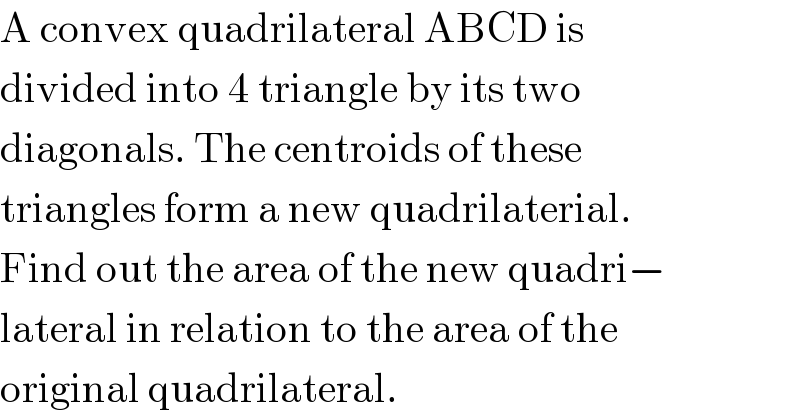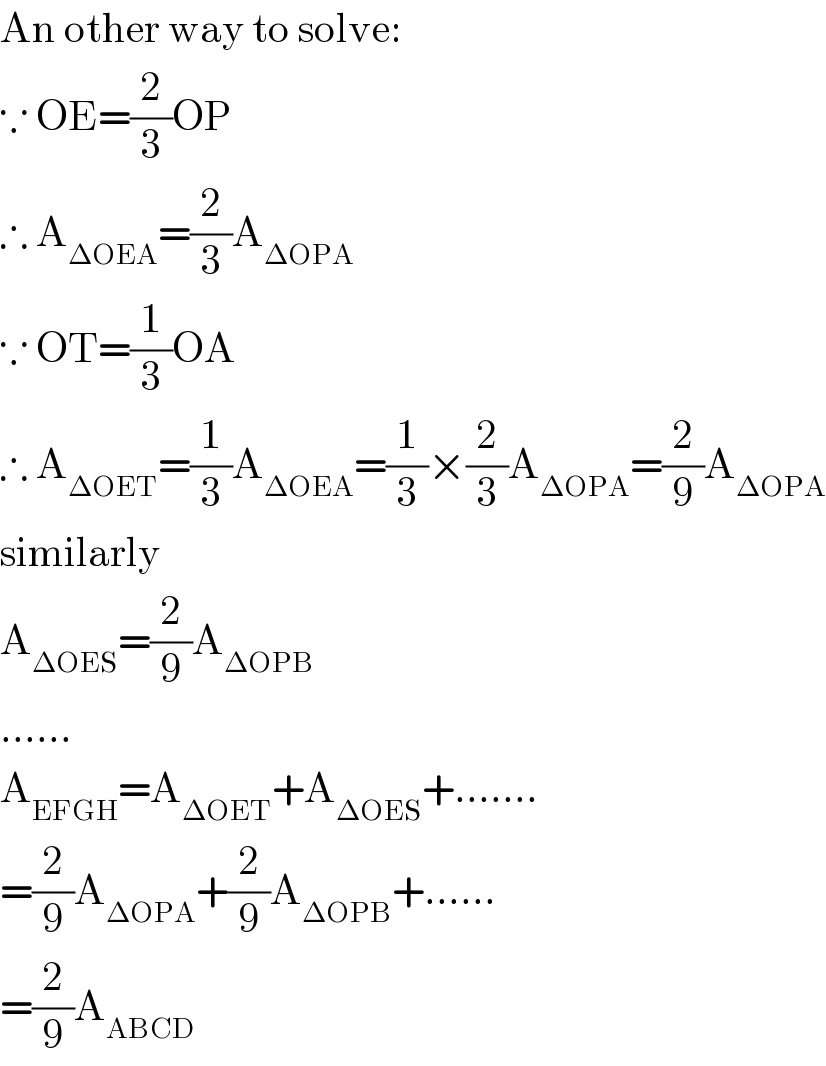Question Number 15904 by mrW1 last updated on 15/Jun/17

Commented by mrW1 last updated on 15/Jun/17

$$\mathrm{A}\:\mathrm{convex}\:\mathrm{quadrilateral}\:\mathrm{ABCD}\:\mathrm{is} \\ $$$$\mathrm{divided}\:\mathrm{into}\:\mathrm{4}\:\mathrm{triangle}\:\mathrm{by}\:\mathrm{its}\:\mathrm{two} \\ $$$$\mathrm{diagonals}.\:\mathrm{The}\:\mathrm{centroids}\:\mathrm{of}\:\mathrm{these} \\ $$$$\mathrm{triangles}\:\mathrm{form}\:\mathrm{a}\:\mathrm{new}\:\mathrm{quadrilaterial}. \\ $$$$\mathrm{Find}\:\mathrm{out}\:\mathrm{the}\:\mathrm{area}\:\mathrm{of}\:\mathrm{the}\:\mathrm{new}\:\mathrm{quadri}− \\ $$$$\mathrm{lateral}\:\mathrm{in}\:\mathrm{relation}\:\mathrm{to}\:\mathrm{the}\:\mathrm{area}\:\mathrm{of}\:\mathrm{the} \\ $$$$\mathrm{original}\:\mathrm{quadrilateral}. \\ $$
Answered by ajfour last updated on 15/Jun/17
![let AO=a, BO=b, CO=c, DO=d and α=∠AOB, ∠BOC=π−α ∠COD=α , ∠DOA=π−α Area_(ABCD) =(1/2)[absin α+ bcsin (π−α)+cdsin α+dasin (π−α)] Area_(ABCD) =(1/2)(sin α)(ab+bc+cd+da) ⇒Area_(ABCD) = (1/2)(a+c)(b+d)sin α ΔAOB and ΔCOB have the same height (with their bases along AC ) = bsin α and their centroids are E and F respectively with height = (b/3)sin α. so EF is parallel to AC. similarly EH , FG // BD. we can conclude EFGH is a parallelogram. let its base be along AC of length =(1/3)(a+c) its height ⊥ to AC =(1/3)(b+d)sin α Area_(EFGH) =(1/9)(a+c)(b+d)sin α = (2/9)×(1/2)(a+c)(b+d)sin α Area_(EFGH) =(2/9)(Area_(ABCD) ) .](https://www.tinkutara.com/question/Q15913.png)
$${let}\:{AO}={a},\:\:{BO}={b},\:{CO}={c},\:{DO}={d} \\ $$$${and}\:\alpha=\angle{AOB},\:\angle{BOC}=\pi−\alpha \\ $$$$\:\angle{COD}=\alpha\:,\:\angle{DOA}=\pi−\alpha \\ $$$${Area}_{{ABCD}} =\frac{\mathrm{1}}{\mathrm{2}}\left[{ab}\mathrm{sin}\:\alpha+\right. \\ $$$$\left.\:\:{bc}\mathrm{sin}\:\left(\pi−\alpha\right)+{cd}\mathrm{sin}\:\alpha+{da}\mathrm{sin}\:\left(\pi−\alpha\right)\right] \\ $$$${Area}_{{ABCD}} =\frac{\mathrm{1}}{\mathrm{2}}\left(\mathrm{sin}\:\alpha\right)\left({ab}+{bc}+{cd}+{da}\right) \\ $$$$\Rightarrow{Area}_{{ABCD}} =\:\frac{\mathrm{1}}{\mathrm{2}}\left({a}+{c}\right)\left({b}+{d}\right)\mathrm{sin}\:\alpha \\ $$$$\:\Delta{AOB}\:{and}\:\Delta{COB}\:{have}\:{the} \\ $$$${same}\:{height}\:\left({with}\:{their}\:{bases}\right. \\ $$$$\left.{along}\:{AC}\:\right)\:=\:{b}\mathrm{sin}\:\alpha\:\:{and}\:{their} \\ $$$${centroids}\:{are}\:{E}\:{and}\:{F}\:{respectively} \\ $$$${with}\:{height}\:=\:\frac{{b}}{\mathrm{3}}\mathrm{sin}\:\alpha. \\ $$$${so}\:{EF}\:{is}\:{parallel}\:{to}\:{AC}. \\ $$$$\:{similarly}\:{EH}\:,\:{FG}\://\:{BD}. \\ $$$${we}\:{can}\:{conclude}\:{EFGH}\:{is}\:{a}\: \\ $$$${parallelogram}. \\ $$$${let}\:{its}\:{base}\:{be}\:{along}\:{AC}\:{of}\:{length} \\ $$$$\:\:=\frac{\mathrm{1}}{\mathrm{3}}\left({a}+{c}\right) \\ $$$${its}\:{height}\:\bot\:{to}\:{AC}\:=\frac{\mathrm{1}}{\mathrm{3}}\left({b}+{d}\right)\mathrm{sin}\:\alpha \\ $$$${Area}_{{EFGH}} =\frac{\mathrm{1}}{\mathrm{9}}\left({a}+{c}\right)\left({b}+{d}\right)\mathrm{sin}\:\alpha \\ $$$$\:\:\:\:\:\:\:\:\:\:\:\:\:=\:\frac{\mathrm{2}}{\mathrm{9}}×\frac{\mathrm{1}}{\mathrm{2}}\left({a}+{c}\right)\left({b}+{d}\right)\mathrm{sin}\:\alpha \\ $$$$\:\boldsymbol{{Area}}_{\boldsymbol{{EFGH}}} =\frac{\mathrm{2}}{\mathrm{9}}\left(\boldsymbol{{Area}}_{\boldsymbol{{ABCD}}} \right)\:. \\ $$
Commented by mrW1 last updated on 15/Jun/17

$$\mathrm{very}\:\mathrm{correct},\:\mathrm{thanks}! \\ $$
Commented by ajfour last updated on 15/Jun/17

$${thanks}\:{Sir},\:{God}\:{bless}\:{you}. \\ $$
Answered by mrW1 last updated on 15/Jun/17

$$\mathrm{An}\:\mathrm{other}\:\mathrm{way}\:\mathrm{to}\:\mathrm{solve}: \\ $$$$\because\:\mathrm{OE}=\frac{\mathrm{2}}{\mathrm{3}}\mathrm{OP} \\ $$$$\therefore\:\mathrm{A}_{\Delta\mathrm{OEA}} =\frac{\mathrm{2}}{\mathrm{3}}\mathrm{A}_{\Delta\mathrm{OPA}} \\ $$$$\because\:\mathrm{OT}=\frac{\mathrm{1}}{\mathrm{3}}\mathrm{OA} \\ $$$$\therefore\:\mathrm{A}_{\Delta\mathrm{OET}} =\frac{\mathrm{1}}{\mathrm{3}}\mathrm{A}_{\Delta\mathrm{OEA}} =\frac{\mathrm{1}}{\mathrm{3}}×\frac{\mathrm{2}}{\mathrm{3}}\mathrm{A}_{\Delta\mathrm{OPA}} =\frac{\mathrm{2}}{\mathrm{9}}\mathrm{A}_{\Delta\mathrm{OPA}} \\ $$$$\mathrm{similarly} \\ $$$$\mathrm{A}_{\Delta\mathrm{OES}} =\frac{\mathrm{2}}{\mathrm{9}}\mathrm{A}_{\Delta\mathrm{OPB}} \\ $$$$…… \\ $$$$\mathrm{A}_{\mathrm{EFGH}} =\mathrm{A}_{\Delta\mathrm{OET}} +\mathrm{A}_{\Delta\mathrm{OES}} +……. \\ $$$$=\frac{\mathrm{2}}{\mathrm{9}}\mathrm{A}_{\Delta\mathrm{OPA}} +\frac{\mathrm{2}}{\mathrm{9}}\mathrm{A}_{\Delta\mathrm{OPB}} +…… \\ $$$$=\frac{\mathrm{2}}{\mathrm{9}}\mathrm{A}_{\mathrm{ABCD}} \\ $$
Commented by mrW1 last updated on 15/Jun/17

Commented by ajfour last updated on 15/Jun/17

$${brilliant}\:{technique},\:{Sir}. \\ $$$$\:\:{thank}\:{you}\:{sir}\:. \\ $$
